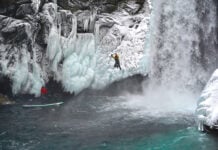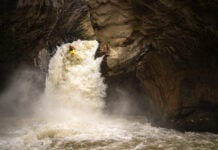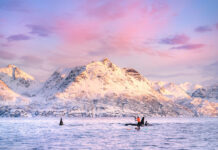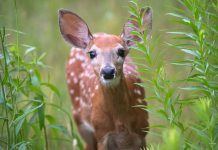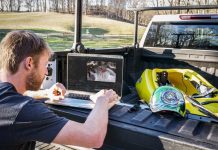At the edge of twilight, a lone paddleboarder glides among giant orcas on the coast of Norway. Above her, snowy mountains bathed in warm light pierce a pink and violet sky.
Images like this don’t happen by chance in the fjords of Arctic Norway. Capturing elusive orcas amid spellbinding scenery and magical, fleeting light at the top of the world is Tommy Simonsen’s specialty. For the Norwegian landscape, wildlife and documentary photographer, the Arctic’s capricious weather and fickle light hold the key to its enduring appeal.
Sublime encounters with orcas in Norway
“Much of November, December and January, the sun simply doesn’t appear above the horizon,” Simonsen explains. “But for a brief time just before the sun disappears in November and after it returns in January, the Arctic light is a gift of pastel colors.” During this time of the year, sunrise and sunset linger for as long as two hours.

Factor in roaming killer whale pods and marauding winter storms, however, and chasing ephemeral cotton candy skies at 70 degrees north is no simple task.
Around 3,000 orcas live in the Norwegian and Barents seas, spending most of the year in offshore waters. Then, from mid-October through January, they enter the narrow coastal fjords of Arctic Norway, following shoals of herring. The whales move around the fjords, so finding them takes experience and more than a little luck.
Simonsen describes a typical day during a January photoshoot: board a small, open boat in the island fishing village of Skjervøy; depart the harbor around 6 a.m. and speed through the Arctic winter darkness, swaddled in a survival suit and insulating layers of wool and down. Wait for the two-and-a-half-hour window around midday when diffuse, soft-hued daylight illuminates snow-covered mountains and—hopefully—the slick, black backs and towering dorsal fins of an orca pod. Watch, compose and shoot as the sky glows intense yellow and pastel pink. By early afternoon, the sun will dip back below the horizon and darkness will reclaim the fjord.
Whether he’s traveling by boat, dogsled or skis, Simonsen relies on a network of talented expedition partners for support and safety. Human subjects also lend a more intimate scale to otherwise austere images of vast, frozen landscapes. Many have become close friends—like standup paddleboarder and Schibevaag Adventure founder, Kari Schibevaag, who leads paddling and snorkeling excursions to experience Norway’s orca whales.
Treating whales with caution and respect
Paddling in such close proximity to 26-foot-long, five-ton marine mammals demands respect and an understanding of their behavior.
“When we see a gathering of whale-watching boats in the fjord, we try to go somewhere else to minimize our impact,” Simonsen explains. “Most of the time, we get lucky and the pods pop up around us. They are often curious about Kari in a peaceful way.”
Making images like these, says Simonsen, is all about patience. Including plenty of extra time in any travel plans is essential. During the winter months, Arctic low pressure systems march across the North Atlantic in quick succession, bringing snow, rain and high winds making it impossible to venture out into the fjords. Simonsen’s advice for aspiring photographers and paddlers: be prepared to wait—for the weather, the whales, the sun or, simply, the right moment.
This article was first published in the Early Summer 2022 issue of Paddling Magazine. Subscribe to Paddling Magazine’s print and digital editions, or browse the archives.
Images like this—of a sublime orca encounter—don’t happen by chance in the fjords of Arctic Norway. | Feature photo: Tommy Simonsen


